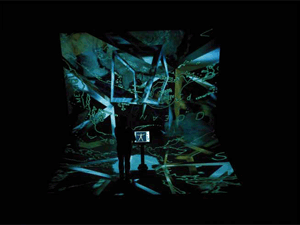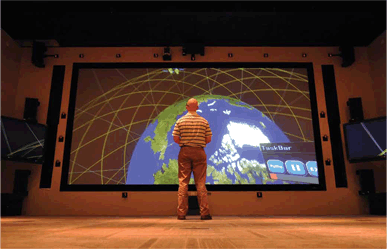In The Fast-Expanding World Of Stereoscopic 3D Projection, Nothing Comes Straight Off The Shelf
Mechdyne, based in Marshalltown, IA, recently worked on a 3D installation that involved almost every current type of stereoscopic projection technology. King Abdullah University and Science and Technology (KAUST), a school outside Jeddah, Saudi Arabia, now has 11 new stereoscopic systems, including a room that comprises a 10-foot by 10-foot cube of S3D displays.
Stereoscopic 3D projection has been with us for decades, but it’s only been in the last two years that threedimensional viewing has exceeded fad status. Now, with theaters adopting digital cinema projectors in great numbers, the ease with which digital images can be manipulated has triggered the current revival of left-eye/ right-eye flicks.
From here onward, almost every major animated release will get an S3D theatrical run, powered in most cases (in the U.S. anyway) by RealD projection and viewing technology. Proving 3D’s potential, Avatar has exceeded even its frantic pre-release hype to become the highest-grossing motion picture in history.
You’re probably familiar with RealD projection, even if you don’t know the particulars. The company claims about 98 percent of the 3D cinema screens in the U.S. RealD makes the gray-tinted plastic glasses you get for free at trade shows; they work in conjunction with the filter in front of a digital projector’s lens to polarize a viewer’s eyes, allowing each eye to see only the intended half of the projected content.
This is, of course, how our eyes themselves create a 3D effect for our brains. Each eye sees a slightly different image of faraway objects— and a violently different view of objects that are right in front of our noses. For a flat surface (a projection screen) to have “depth,” each eye needs a different image, but one with perfectly synchronized common elements (such as a background). To achieve this effect, a display system needs either dual projectors or one projector that can serve images at double their usual rate (so 60Hz becomes 120Hz). There also needs to be a device— either glasses that actively switch off the right and the left eye, or a polarizing lens filter that works in conjunction with passive glasses— that effectively splits the left and right eyes and aligns them with their corresponding images.
Active Stereo
Much more expensive than RealD’s dollar specs are active stereo glasses. At the low end, active glasses are still at least $60 a pop. These glasses have LCD shutters that very quickly block out the eyes in sequence. Typically an infrared transmitter at the projector sends a pulse that drives the shutters, keeping everything properly in synch.
Alternatively, XpanD active stereo glasses (and some RealD active models) require no IR transmitter. To switch from left to right, they read a white signal that the DLP chip flashes in between frames. This communication protocol is known as DLP-Link. In all of these active systems, a single projector operates at 120Hz.

Instead of red and green, a newer technology known as ColorCode tweaks the light of the projectors (or in this case, a laptop) towards blue and yellow..
Mechdyne, based in Marshalltown, IA, recently worked on a 3D installation that involved almost every current type of stereoscopic projection configuration. King Abdullah University and Science and Technology (KAUST), is a graduatelevel research institution at Thuwal, Saudi Arabia, now has 11 new stereoscopic systems, including a room that comprises a 10-foot by 10-foot cubic room of S3D projection. “If you come to us for a recommendation based on image quality,” said Kurt Hoffmeister, vice-president of engineering and R&D for Mechdyne, “we would readily recommend active stereo. But if we were to split up projects done over the last few years, you would see a mix.”
In the U.S., Mechdyne installed an active stereo system at the facilities of the U.S. Army Armament Research, Development and Engineering Center (ARDEC) in Rock Island, IL. Built in a space the size of a shipping container, their four-sided immersive S3D environment allows engineers to design, at 1:1 scale, working environments (such as machine shops and portable hospitals) that will actually be built into shipping containers. The ability to get feedback from actual users before any building occurs has already saved ARDEC millions of dollars, says Mechdyne.
Passive Stereo
Passive stereoscopic projection is popular for one main reason: the cost of the glasses. “I think the bigger the group, the more sense passive makes,” said George Walter, vice president for home cinema for Digital Projection International (DPI). “The reasons for that today anyway are statistical. Somebody’s glasses might not be turned on properly. Then there’s the cost issue.”
Indeed, movie theaters use RealD’s circular polarization for one main reason: the attendant cheap glasses that audience members can recycle after the show—or keep. Passive stereo technologies can be broken into two main categories: light polarization and chroma separation.
Polarization can be linear or circular. IMAX 3D theaters, for instance, employ linear polarization technology with two projectors. One projector has a filter that polarizes the image vertically, and the other does so horizontally; those two images correspond to either eye. “There’s one drawback with linear polarization,” said Frank Sheehan, technology director with Visual Acuity of Brighton, England. “If you rotate your head, the polarization changes. There’s crosstalk, which creates a ghosting effect.” This means that one eye can see parts of the image that are intended only for the other eye.
Generally a more expensive technology than linear polarization, circular polarization spins light clockwise for one eye, and counterclockwise for the other eye. Sheehan said for systems that expect audience members to move, such as immersive environments that involve a tracking system whereby the image moves with the viewer’s head or eye position, circular polarization eliminates much of the ghosting that can plague linear systems.
Chroma separation systems are somewhat related to the familiar red-and-blue anaglyph systems that epitomize the 3D movies of the 1950s. These passive stereo systems are far subtler than anaglyph systems, however, and produce much more faithful color representation. Chroma separation requires two projectors fronted with frequency-selective glass. With InfiTech technology, one lens filter is notched toward red, and the other toward green. (There’s also a firmware change to the projectors to effect a chroma offset.) Instead of red and green, a newer technology known as ColorCode tweaks the light of the projectors toward blue and yellow.

Two of projectiondesign’s F10 AS3D active stereo DLP projectors are used at the ZKM | Center for Art and Media, in Karlsruhe, Germany, for the re-staging of a virtual AV installation called “reconFIGURING the CAVE” by media artists Agnes Hegedues, Bernd Lintermann, and Jeffrey Shaw. In the middle of the room is an interactive touchscreen that displays a miniaturized version of the original CAVE interface. As the visitor manipulates the touchscreen image, the projected images shift and change in proportional, yet unexpected and interesting ways.
Based on Infitec technology, Dolby 3D Digital Cinema involves a rotating color wheel that effects the color shift to separate the left eye and right eye images. This wheel lifts mechanically from in front of the single 120Hz projector for 2D presentations. One prominent installation of Dolby’s 3D technology is the 3D theater in the new California Academy of Sciences in San Francisco. Visual Acuity served as technical consultants on the planetarium and the 3D theater.
At the Projector
For most active and many passive stereoscopic 3D installations, a single 120Hz projector is required to send 60 images to the left eye and 60 images to the right eye in a single second. (RealD systems use a 144Hz projector that sends frames the normal film rate of 24fps thrice to each eye per second.) Sheehan lists Christie, Barco, projectiondesign, Lightspeed Design, and DPI as the only manufacturers that currently offer off-the-shelf projectors in the 120Hz class.
To fulfill that requirement, projectiondesign offers the F10 AS3D projector, a first for a single-chip model. “The projector can be set up in a stereoscopic 3D mode within a minute after you have your laptop ready,” said Trond Solvold, product and application manager for projectiondesign. “You should not need to be an engineer to set up the image on wall—ease of use is a must.” projectiondesign’s F10 AS3D and its three-chip 120Hz models support traditional IR-driven glasses in two modes, and DLP Link.
Mechdyne has helped push Digital Projection toward creating stereofriendly projector features, Walter said. Adjustable dark time technology, for instance, leverages the ability of DLP’s micromirrors to move faster than 120Hz. Dark time is added on a pixel-by-pixel basis. The two companies have unveiled a high-end home-theater system, using a Titan or Lightning 3D projector from DPI and Mechdyne’s Dimension 3D media server.
Hoffmeister of Mechdyne advises that whatever brightness rating a projector might have, adding 3D glasses and lens filters to the equation will pull down that number significantly. “Regardless of the technology used, whether passive or active, there’s quite a bit of light loss in the technology today,” he said. “One of the things we’ve put R&D into is ways of getting as much efficiency and brightness as the technology allows.”
